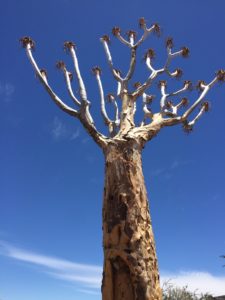
The Quiver Tree Forest is actually comprised of towering aloe plants. Photo by Karen Shigeishi-Waite.
In this two-part series on Namibia, veteran travel writer Robert Waite continues his series of pieces from outposts around the world, which have taken us from far western Canada to East Africa, Southeast Asia to Eastern Europe, and now to remote southwestern Africa.
I asked Bob what attracts him to places like Namibia, which, while gaining in popularity as a tourist destination, is still off the beaten track.
“I’m drawn to places that might easily be overlooked,” Bob says. “Namibia was a place I initially knew little about, but the more I researched it, the more I became intrigued. I also realized that safaris there were likely to be less crowded than one might find in South Africa or Kenya — which turned out to be the case.”
Here’s Part I of Bob’s piece on Namibia, which takes him through a stretch of the Kalahari Desert to an odd kind of forest, the world’s second largest canyon, an old mining-turned-ghost town — and past a number of places offering a surprise desert dessert….
By Robert Waite
Windhoek, Namibia – Nothing quite says Mitteleuropa like strudel. Wherever we went, a cafe or restaurant claimed to serve “the country’s best strudel.”
Where was this, you might ask — Vienna, Berlin or, perhaps, Budapest? Nope. Namibia — the country formerly (if somewhat unimaginably) known as Southwest Africa.
In the late 19th Century, a recently united and ambitious Germany decided it wanted to get into the colonization game. As a late starter and with much of Africa in the hands of others, the Germans turned their attentions to an unclaimed (and unappreciated) stretch of arid land bordering Angola to the north and Cape Colony (now South Africa) to the south.
The region has a long but treacherous Atlantic coastline first explored by the Portuguese. The name on subsequent charts – the “Skeleton Coast” – and the punishing Namib Desert combined to dissuade European incursion.
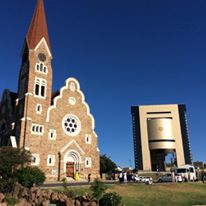
A Lutheran church in Windhoek is typical of Namibia’s German architecture. Photo by Robert Waite.
None of this stopped the Germans. They found a safe spot for a port along the coast. They found a place in the middle of the country with enough water to establish a capital and administrative center. They also discovered minerals, including diamonds.
Lingering Influence
The colonizers also brought Germany with them, everything from architecture, to Lutheranism, to beer and, yes, apple strudel. All of this was relatively short-lived – as First World War losers, Germany gave up its handful of colonies. But even today, you can see (and taste) the lingering influence.
Namibia is big – 22 percent larger than Texas – and has much to see. We allotted 12 days to view the country’s wide range of attractions, traveling in a small bus with a driver/guide and a few fellow passengers.
After a day in the attractive capital city, Windhoek, with its mix of vintage German and modern architecture, our group of 11 headed south out into the Namibian portion of the Kalahari. This semi-arid desert boasts the world’s largest contiguous stretch of sand, stretching across nine African nations.
Unlike a true desert, the Kalahari does receive erratic rainfall and supports a surprising abundance of life, much of it centered near water holes. We went on a dune drive and were treated to loping giraffes, a lumbering Kalahari tortoise, wildebeests, oryx, and ostriches, all before sundown.
And of course, at sundown came the “sundowner,” an African tradition typically involving gin or vodka tonics and, in this instance, the local brew, Windhoek, a consistent gold medal winner at German beer competitions.
Sprechen Sie Deutsch?
The next day we continued south through expansive rocky plains. By this point we had discovered that we were the only non-German speakers on board – others were from Germany, Austria and Switzerland. Our guide, Udo, while advertised as equally facile in English or German, seemed to speak for ten minutes in German…and then translate a scant three words into English.
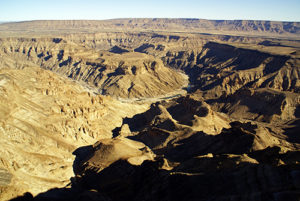
Namibia’s Fish River Canyon is by some measures the world’s second largest. Photo by Dennis Cox/WorldViews
Fortunately, a young Swiss woman, Anna, turned out to be a translator by profession and offered to let us in on what we were missing. But the tip here is to always question your travel advisor closely regarding your guide’s language capability… and his or her propensity to use it.
The roads in Namibia are surprisingly good for a country so large and a population, 2.5 million, so small. As with much of the newer infrastructure in Africa, the benefactors were the Chinese.
We were heading towards the Fish River Canyon, the second largest on earth by surface area, measuring 160 km (100 miles) long by up to 27 km (17 miles) wide.
Along the way we stopped to visit the Quiver Tree Forest.
These “trees” are actually a species of aloe plant. To me they looked like gigantic broccoli stalks stretching more than ten meters (35 feet) into the sky.
Nearby is a kind of sculpture garden fashioned by the local inhabitants from discarded items found in the desert. It all made for excellent photos (and provides a bit of income for the locals).
Impressive Canyon
The Fish River Canyon itself is interesting and it’s worth taking a short hike down to the river itself, the largest in the country’s interior, but clearly today only a trickle compared to the torrent that gouged out the canyon in earlier geological times.
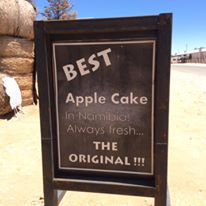
A sign in the desert promising “the best” apple cake (strudel). Photo by Robert Waite.
By now we have turned east, heading towards Luderitz on the Atlantic coast.
Along the way there are several vantage points near a place called Garub where you can observe wild horses in the distance as they come down from the hills or across the plain to drink at watering holes. It is not known how the horses got here – some say they escaped from shipwrecks; others that they slipped away from their German masters.
After staying overnight in Luderitz, we backtracked six miles to arrive at a ghost town, Kolmanskop. Founded in 1912 and once the site of a thriving diamond mine, the various buildings are now hauntingly empty and endlessly besieged by blowing sand.
Everything you see here – the theatre and music hall; the bowling alleys; the school; the mining offices; the workers’ quarters – was brought from Germany to Luderitz, then taken overland, and reassembled.
The surrounding area was declared “sperrgebiet” or forbidden by the colonial masters. The local Namibian Herero people, already decimated by a German genocidal campaign that took 60,000 lives, were forced to either move away or work at the mine. The German overlords kept their black employees in separate (and quite unequal) housing a distance from the white workers and administrators.
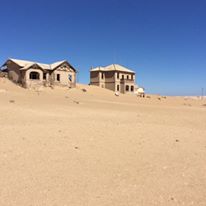
This sand-blown ghost town was once a prosperous colonial-era diamond mining center. Photo by Robert Waite.
Of course, if you were European, life was good. The town was so prosperous that European opera companies graced the theatre’s stage from time to time and inhabitants enjoyed the luxury of an ice-making factory, using water shipped by sea and then transported by railroad tanker car.
An interesting museum on site outlines the many ingenious ways miners devised to try to smuggle out diamonds – as well as the various methods used to stop them, including the first recorded use of x-rays to thwart crime.
Sand is a constant in this region and its movement is so relentless that an effort to build a railway from the coast further into the interior ultimately failed — not because the tracks could not be laid, but because they could not be kept uncovered for more than a few hours.
Blowing sand might have been the undoing of the railroad, but it has created a tourist delight – the magnificent dunes of the Namib Desert. We were on to the surreal Deadvlei, surrounded by the highest dunes in the world, and Sossusvlei, where the mostly dry Tsauchab River ends abruptly among the majestic dunes.
End of Namibia, Part I. Coming up: Namibia: Dunes, Oysters, and Wildlife
If You Go
Namibia travel arrangements were made through Cederberg Travel Africa. Lufthansa flies to Windhoek from Frankfurt; South African Airlines does so from Johannesburg.
The Avanti Windhoek Hotel provides good, centrally located accommodation in the capital. A good place for dinner is Joe’s Beer House, which features a selection of wild game in addition to an array of excellent beers.
In the Kalahari we stayed at Intu Africa Camelthorn Lodge; in Luderitz we found excellent accommodation at the Nest Hotel. In the Nabib Desert we stayed at The Elegant Desert Lodge, which lived up to its name.
You can safely self-drive in Namibia, but bring lots of water and refuel frequently, as gas stations are few and far between. And the best strudel? I leave it to you to decide.
Author Bio: Robert Waite has written on travel for almost 50 years. A former Pacific News Service correspondent in Eastern Europe, he is a professor at Seneca College in Toronto and Managing Partner at Waite + Co., a communications consulting firm with offices in Boston, Ottawa and Toronto.
Previous posts by Robert Waite include:












Leave a Reply